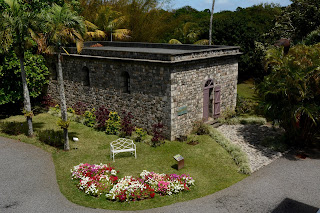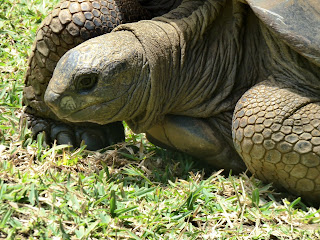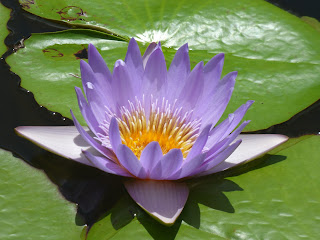In a nutshell: much smaller than Tasmania but with 1.2 million people; uninhabited until 1598; a French then English colony, now a republic; multi-cultural (Indian, African, Creole, Malay); diverse landscape of mountains, beaches, deep valleys and forests; many endemic and rare birds and flora; economy based on agriculture, sugar, tourism, financial services; while English is the official language, 95% of people speak Creole (a phonetic version of French).
First up was a day trip to the capital Port Louis. We took the local bus for a few rupees. The waterfront has been developed for tourists so was modern and clean. There was a large shopping precinct, cafes, a cinema and outdoor restaurants.
Here I found a statue to Nicolas Baudin, the French explorer (who also sailed through Encounter Bay and named the Fleurieu Peninsula where I live, back in 1802). On his return journey from mapping the coast of New South Wales his ships stopped in Mauritius where he died of tuberculosis, hence the commemorative bust.
Hinduism accounts for almost half the population's religion and there are many Hindi temples here. We visited Kannanur Mariamman Kovil, a very colourful encounter.

We visited the huge covered market which was colourful, noisy and bustling with shoppers.
Steve takes a photo of other tourists in this vast and rather forbidding-looking space.
The following day (by now with our hire car) we visited two French colonial mansions; there are few of these left on the island, but the ones that have been saved and restored are charming and very evocative of times past - just my cup of tea. La Demeure de Sainte Antoine, built in 1830, is now a restaurant and upmarket guesthouse, so no actual cost to wander around. It was simply lovely.
 |
| The house |
 |
| Miss Glamour trying to recreate a 19th century vibe. |
 |
| The restaurant |
 |
| The owner's private house |
The next house was the Chateau de Labourdonnais. Built in 1859 it was beautifully furnished with French and English pieces, and also had a rum distillery. As in all these homes, the rooms have large French doors opening onto wide verandahs, creating natural airconditioning.
The chateau was approached via a long allee.


This was the gorgeous wallpaper...
... and a bedsheet...
... and a sumptuous French painting.
Outside, the original sugar mill still stands. The tree in front is a coral tree, so imagine it in full scarlet bloom.
We wandered the grounds...
... saw the old kitchen ...
... spied some large tortoises...
... and had a rum tasting.
Our botanical fix came when we visited the Pamplemousse Botanical Gardens. Originally the governor's 1735 vegetable garden, it was redesigned in the 1770s, and its 37 hectares are packed with an amazing variety of palms (one palm, the 25metre-tall talipot, bears flowers once in its lifetime of 30-80 years then dies), lily ponds, lotus, bamboo groves, spices, giant tortoises, bats (Mauritius' only endemic mammal) and deer (an introduced species). It claims to be the oldest botanical gardens in the southern hemisphere.
The next day we drove across the top of the island from east to west. Disappointingly, we did not see the coast!!! What? We were driving right along the narrow coast road. But this is the domain of exclusive resorts, luxury hotels and private homes hidden behind tall stone walls which gave us tantalising glimpses of lush tropical gardens beyond. And here in the north of Mauritius, most of the beaches are private. A pox on the rich. There is only one public beach along the entire northern coastline, and a small one at that.
I really wanted to see the cannons and fort situated on a small promontory in the far north-west. I had read that the French had used the site as a garrison and battery and the British as a military and quarantine post. Not much remains, and today these colonial relics are unfortunately in the grounds of a swish golf resort in Grande Baie, the main resort town in the north. Steve talked to the man at the gate who interrogated us, and, just short of asking for our passports, called up reception and we were allowed in - though of course we had to report to reception and provide our credentials. High security indeed. But it was a pleasant experience walking these hallowed grounds and we eventually found the cannons ...
... and the garrison, which is now a teenagers' retreat.
The next day we drove a short way down the western coast to Mont Choisy, which was a public beach. It was a long beach with lots of lawn and plenty of shade.
Ok so I didn't swim as the water was a bit too cold but I did admire the peaceful, turquoise water. And I saw this little bird which I later discovered is very common and is grandly named the red-whiskered bubul.
And I saw this little bird which I later discovered is very common and is grandly named the red-whiskered bubul.
Later, we tried to find a lake, got lost, but did get some good views of a typical town in the mountains and Mauritian scenery...
I absolutely loved the tropical plants we saw with their vivid colours set against emerald green leaves. Here is a sample. Not sure of any of the names.
For our last night in the north we went to a gorgeous seafood restaurant. I quote here from my diary, though be warned, I wrote this at the end of a long day and the prose would never win a Booker prize.
The sun had not yet set, so for half an hour or so we admired the view from our table on the terrace - boats moored in the bay, calm water lapping the rocky shore, the apricot hues of the setting sun casting a gentle glow. The service was great, the food really good (a ruby schnapper for Steve followed by a hot chocolate pudding, tiger prawns in a ginger sauce for me and a creme brûlée).
And so ends our northern Mauritius sojourn. We found the people very friendly and helpful, the many fish dishes we ate were extremely yummy, the landscape diverse and lush, and the main highways excellent. However, all other roads were narrow and clogged with traffic, signposting or the lack of it drove us mad, and there were far too many private beaches.
I'll finish with two lasting impressions of the north.
1. Delicious fruit juices and curries.
2. Endless fields of sugar cane.
Next up - central and south Mauritius. Coming soon.......
















































It's all so rich and vibrant - although the rich didn't look so vibrant on their private beach. Cautionary tales for places desiring to become tourist meccas... XXXX
ReplyDeleteDespite some misgivings, you've made it look impressive with your photos. I suspect that life has always favored the wealthy families on Mauritius.
ReplyDelete